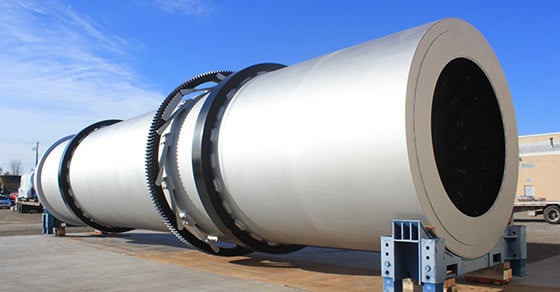Rotary dryers offer a highly flexible solution to drying bulk solids ranging from specialty chemicals to minerals and ores. But with all this flexibility and opportunity for customization often comes confusion on what configuration will provide the most efficient solution for the job at hand.
The best practices listed here provide an informative guide to navigating some of the most important decisions when it comes to rotary dryer design.
Test a Representative Sample Prior to Rotary Dryer Design
Testing a representative sample in a facility such as the FEECO Innovation Center prior to designing the commercial-scale dryer accomplishes a few critical objectives:
- It confirms feasibility of the intended process
- It establishes basic process parameters and key data points
- It identifies any potential issues the process could encounter prior to any substantial investment
Even when feasibility of the drying process has already been confirmed, testing can still provide valuable data, informing engineers on many of the design decisions listed here.
Choose the Right Configuration (Direct or Indirect)
Rotary dryers are available in either the direct or indirect design configuration, with each design suited to different settings. In some cases, the choice may be clear based on special material requirements, such as the need for an inert processing atmosphere. In other cases, the best configuration may be established through testing.
In general, indirect dryers are less efficient, but essential when working with particularly fine solids in order to avoid excessive entrainment (particle carryover). The indirect style is also chosen when the material to be dried must not come into contact with combustion gases.
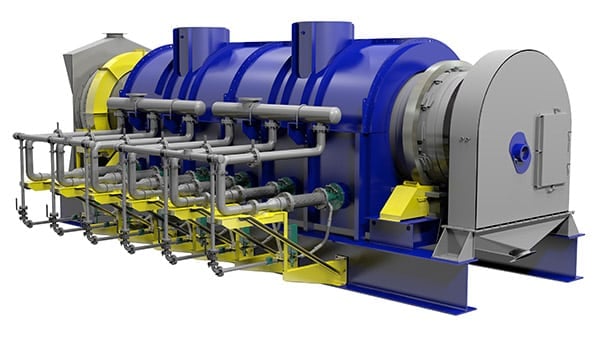
Indirect dryers are enshrouded in a furnace which externally heats the drum to avoid direct contact between the heating medium and the material being dried.
Evaluate for Proper Air Flow
When working with a direct configuration, the air flow configuration is another major decision in the rotary dryer design process. The process gas can feed into the dryer at the same end as the combustion, flowing in the same direction as the material (parallel or co-current flow), or it can be fed in the opposite end, flowing in opposition to the material (counter-current flow).
Each configuration offers a unique approach to drying that may or may not be suitable depending on the process and product goals.
A co-current air flow is generally best for heat-sensitive materials and offers rapid free-moisture removal. For this reason, it is the most commonly employed type, while counter-current air flow is more thermally efficient, but is more susceptible to overheating the material and attrition of the material. More information on co-current vs. counter-current drying >>
Optimize the Flight (Lifter) Design
Flights, or material lifters, have the potential to significantly enhance or hinder drying, providing a valuable opportunity to optimize process efficiency. Individual flight design, as well as the overall pattern or layout of the flights can be customized to improve heat transfer, promote gentler handling, discourage sticking, and more.
As such, the flights should be given significant consideration during the design process. While many decisions can be made based on the material characteristics, testing with a pilot dryer or flight simulator can help to identify the optimal configuration.
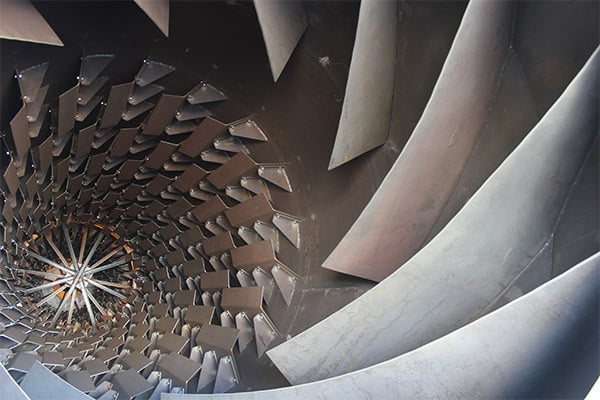
The image above shows lifting flights as well as advancing (spiral) flights inside a FEECO Rotary Dryer.
Consider a Combustion Chamber
Combustion chambers have traditionally been employed to house the combustion reaction when the material to be dried cannot come into direct contact with the flame. However, they are becoming more popular in other process settings for the many benefits they can offer.
In addition to preventing contact between the material and flame, the inclusion of a combustion chamber can not only improve heating efficiency, lowering fuel costs, but it can also reduce emissions, helping plants to meet regulatory requirements. Combustion chambers are also helpful when a material is sensitive to radiant heat.
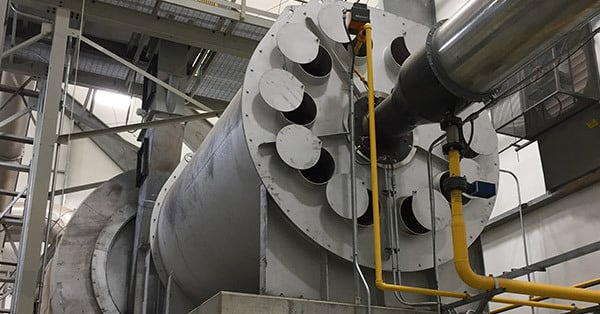
A burner mounted to a combustion chamber on a FEECO Rotary Dryer.
Optimize the Feed Area
In a co-current dryer, where the material and products of combustion feed into the same end of the drum, it is essential to optimize the feed area.
Ideally, the inlet dam, which serves to prevent back spill, will be as high as possible. However, it is also desirable to maximize the air volume coming into the dryer, so the inlet dam cannot be too high, or it will block air flow.
The feed chute, which will ideally be as large as possible, must also be incorporated into this area, further complicating things. As such, designing the feed area is one of the most complex aspects of dryer design, requiring a high level of engineering and expertise.
One technique is to use spiral or advancing flights. Spiral flights can be employed at the inlet to help move material away from the feed location to discourage backspill and keep the area from becoming clogged.
Consider Any Material Challenges
In addition to designing the dryer around the material’s basic characteristics, it’s important to identify any challenging characteristics the material may present up front so they can be accommodated in the design.
The three most common issues are corrosion, abrasion, and stickiness. The first two are typically addressed through the selection of materials of construction, and the third may include the addition of components such as knockers, and sometimes the incorporation of a “bald” or flightless section at the inlet.
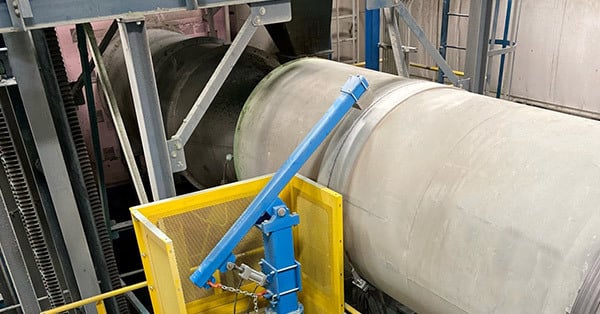
FEECO Side-Mounted Pneumatic Hammer Knocker for reducing buildup in a rotary dryer
Consider the Level of Duty Required During Rotary Dryer Design
As with most equipment, rotary dryers are available in a variety of grades, from light-duty to heavy-duty and everything in between.
Rotary dryers provide the best results when they are designed around the specific characteristics of the material to be dried and the unique processing conditions. This requires that dryers be matched to their intended level of duty.
It may be tempting to cut corners to lower the initial capital cost of the unit, but this approach often ends up being more costly in the long run; under-designed dryers typically incur higher maintenance costs, more downtime, and often fail prematurely.
Proper dryer design by an experienced dryer supplier is essential to ensuring the dryer can provide a long-term, reliable fit in its specified role.
Evaluate Fuel Options
With factors such as location, availability, and cost coming into play, drying plants don’t always have a range of fuel options at their disposal. When options are available, however, it’s important to understand the advantages and disadvantages of each.
Plants utilizing fuel oil, for example, will require a more complex fuel feed system and have higher emissions.
Synthetic gas (syngas), where available, can provide a cost-effective, and sustainable fuel option, but can make finding a burner to utilize it tricky.
If waste heat is available on site, this can be used as a supplement to other fuel sources to reduce energy costs.
In some cases, it may be beneficial to utilize more than one type of fuel. In this case a dual fuel burner can be incorporated into the design to allow operators to switch between fuel sources as needed.
Choose a More Efficient Drum Size
A common practice in rotary dryer design is to oversize the drum diameter to accommodate a more aggressive air volume. While this approach isn’t necessarily wrong, it is not as efficient.
The larger diameter drum helps to combat the potential for material to become entrained in the air flow and carried out through the exhaust gas system. By optimizing the size of the knockout chamber/discharge breeching, however, the drum diameter can be brought down while still allowing for a higher air volume, without excessive entrainment. This makes the system more efficient and lowers the overall capital cost of the unit.
Optimize the Off-Gas Handling System
A good off-gas handling system is not only essential in meeting emissions requirements, but also in maximizing process efficiency.
Ducting should be designed to encourage optimum air flow rate. An industrial fan should be set up to assist in pulling air through the system to create a slight negative pressure in the drying unit.
Typical off gas handling systems include cyclones alone, cyclones and scrubbers, scrubbers alone, or baghouse alone, followed by an induced draft fan.
Include a Controls System
The controls system serves as the brain behind the dryer; in addition to starting up and shutting down the unit, it gives operators the tools they need to adjust settings during times of start-up, fluctuation, or upset conditions.
A good controls package also allows operators to optimize the process for maximum efficiency during normal operating times. A common goal is to minimize fuel usage; by fine-tuning process parameters through the controls system, operators are able to hone-in on the most efficient operating conditions.
Numerous options are available for controls, ranging from the most basic, to extremely advanced. FEECO recommends a minimum of a programmable logic controller (PLC) to automate startup and shutdown. For monitoring and adjusting the operation remotely, a human-machine interface (HMI) should also be incorporated, though this can be added at a later time.
Conclusion
Rotary dryers are a high-capacity, reliable solution to drying bulk solids, but they should be engineered around the intended application for efficiency and long-term reliability. By following practices such as testing the material first, evaluating air flow configurations, optimizing flight design, and more, buyers can assure their dryer will operate efficiently and reliably.
FEECO provides the world’s most reputable rotary dryers, with hundreds of dryer installations worldwide. Each FEECO dryer is designed according to rigid quality standards and engineered for optimal processing and reliability around the specific material to be dried. We offer a testing facility for confirming feasibility and gathering process data, as well as a comprehensive parts and service program. For more information on our rotary dryers, contact us today!



